Ultimate Guide to Exercises for Lumbar Herniated Disc Relief 2
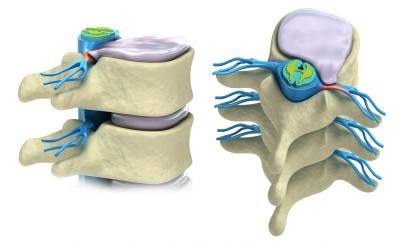
Did you find our previous article, “Disc Herniation Part 1,” helpful but are still battling discomfort? Are you eager to discover exercises that can effectively reposition your herniated disc and enhance your well-being? You’re in the right place.
In this comprehensive guide, we’ll cover:
- Effective Exercises for Repositioning a Herniated Disc: Learn the top movements to gently coax your disc back into alignment, reducing pain and improving mobility.
- Stabilization Techniques to Prevent Disc Displacement: Discover exercises that strengthen your core and back, ensuring your discs stay in place.
Understanding Lumbar Disc Herniation:
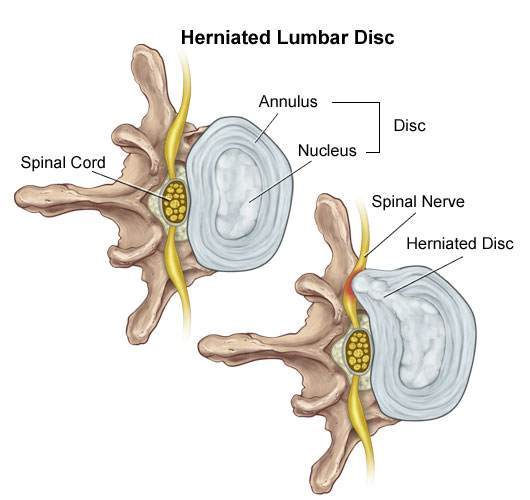
A herniated disc occurs when the disc’s nucleus breaks through the annulus, as shown in the illustration from neurosciences.beaumont.edu. But what triggers this displacement? The primary culprit is forward bending, which compresses the disc (think of it as a jelly-filled doughnut) and can lead to the annulus fracturing, allowing the nucleus to protrude and press against nerves.
Why Does it Hurt?
The disc’s exterior is tough cartilage, while its interior is softer, akin to mucus. Applying pressure on one side forces the inner material to the opposite side, similar to squeezing a doughnut. When a herniated disc or inflammation puts pressure on a nerve, pain ensues. The key to relief is applying counterpressure to reposition the disc.
For a deeper dive into herniated discs, refer to “Disc Herniation Part 1: Best Self-Treatments for Lumbar Disc Herniation.“
How to Apply Counterpressure:
The strategy involves bending your spine backwards or into the extension to shift the disc away from the nerve.
Exercises to Reposition a Herniated Disc: Note of Caution:
Initially, these exercises might intensify your pain slightly. If pain significantly worsens or radiates further down your leg during these exercises, cease immediately and consult a professional.
Exercises for Lumbar Herniated Disc
#1 Prone Lying Lumbar Herniated Disc
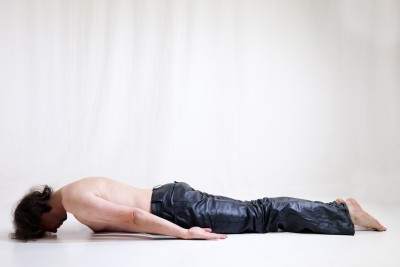
- Lie face down or prone in bed with your elbows tucked in under your side:
- As soon as you get up in the morning you should lie prone (face down). By getting in this position, your lower back becomes more arched, or as doctors say, you increase your lordosis.
- The increased lordosis pushes on the back of the disc helping to bring the nucleus forward into the correct position.
#2 Sphinx pose in Yoga For Lumbar Herniated Disc
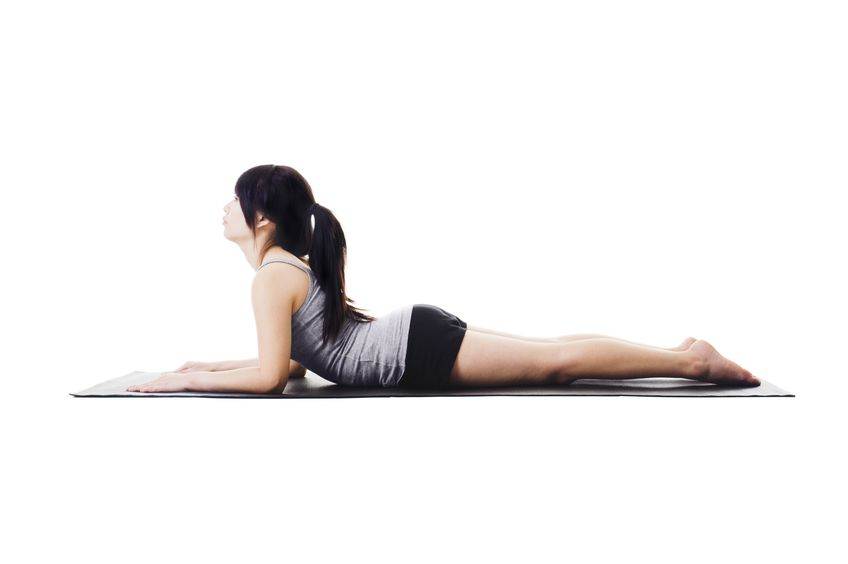
- Get into the prone position lying down on your stomach.
- Next, get on your elbows. If you have a hard time with this position go back into the prone lying position.
- Do these exercises hold each time for 1-2 seconds 6-8 times per set? This exercise can be repeated every two hours throughout the day.
Asses yourself. If the pain has decreased or the pain has moved away from the leg or thigh and into the hip or buttock, this is an improvement. Even if the pain is increased in the back but relieved in the leg this is an improvement and a green light that you should continue this exercise. You also get a green light if there is no difference at all.
- If your self-assessment gives you the green light, move on to the Cobra exercises just below.
- If your thigh or leg pain is worse, then stop right away.
- If your lower back, thighs and legs are the same you get a green light, so move on to the Cobra exercises.
#3 Cobras For Lumbar Herniated Disc
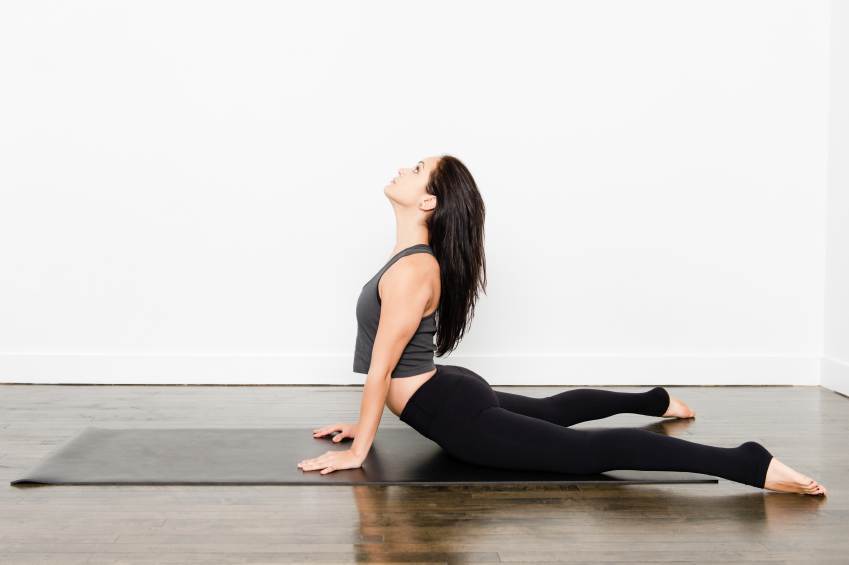
- Lie down face down with your hands underneath your shoulders.
- Push up from as high as you can until your lower back stops you or your elbows are straight.
- The pelvis should still be on the floor and the lower back muscles relaxed.
- Do these exercises hold each time for 1-2 seconds 6-8 times per set? This exercise can be repeated every two hours throughout the day.
Asses yourself. If the pain has decreased or the pain has moved away from the leg or thigh and into the hip or buttock, this is an improvement. Even if the pain is increased in the back but relieved in the leg this is an improvement and a green light that you should continue this exercise. If your thigh or leg pain is worse, then stop right away.
#4 Standing Extensions Lumbar Herniated Disc
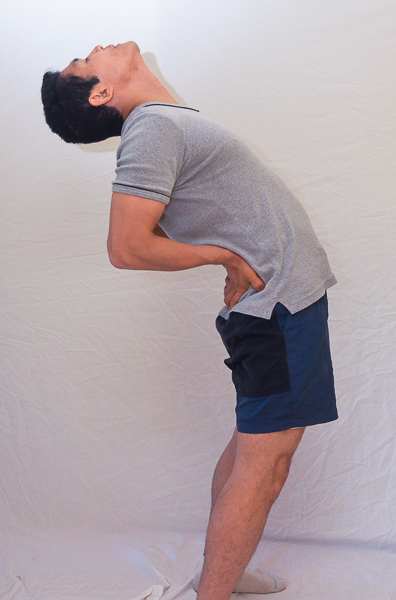
- Stand straight and put your hands behind your hips with your fingers facing down.
- Push your hands into your pelvis so that your lower back arches.
- Don’t use your lower back muscles
- These exercises can be done 6-8 times for 1-2 seconds. This exercise can be repeated every two hours throughout the day.
Stabilization Exercises: Prevent Your Disc From Coming Out By Having A Stable Spine.
#1 Cat-Camel or Cat-Camel For Herniated Disc
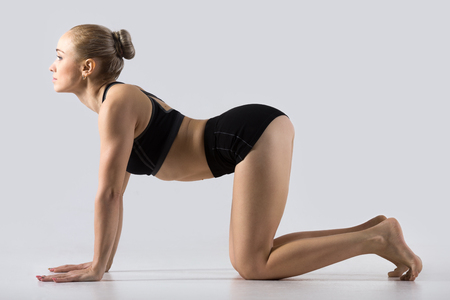
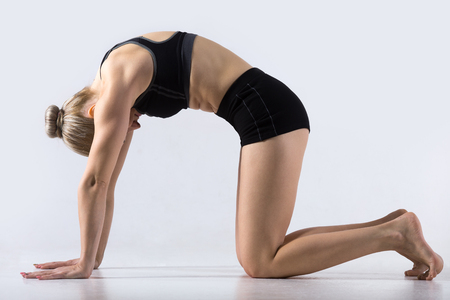
- On all fours with your knees under your hips and hands under your shoulders.
- Inhale and let your belly fall downwards toward the floor as you look up toward the ceiling for 2 seconds.
- Exhale and arch your back up as far as it will go or until you feel pain. You should not feel pain with this exercise, otherwise you are going too high.
- At the same time bend your neck forward and look toward your navel.
#2 Curl-Ups
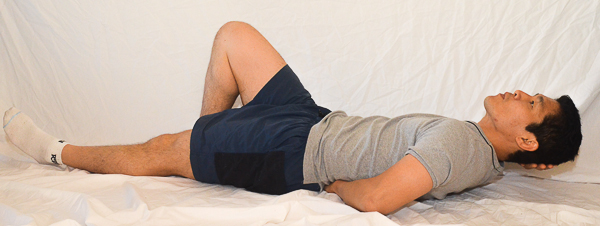
- To start, one foot is bent and the other is straight.
- One forearm goes under the arch of your lower back to support it.
- The other arm is supporting your head.
- Your head and neck come up as one block until your shoulder blades clear the floor.
- Do three sets of 5 working your way up to 10. If it’s easy, then hold for a couple of breaths.
#3 Squats
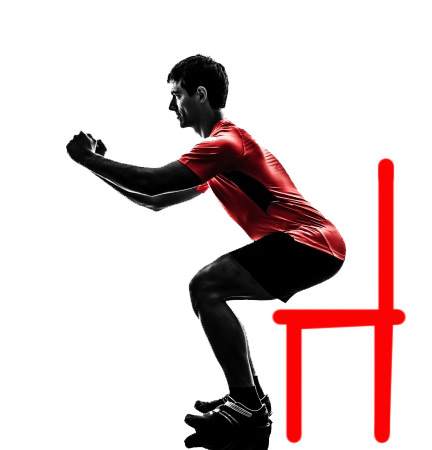
- Stand in front of a chair as if you are going to sit on it.
- Stand with your feet facing slightly more outward than your knee.
- Make sure your butt comes out, and keep lowering your butt until you touch the chair.
- Practice 3 sets of 10.
#4 Bird Dog
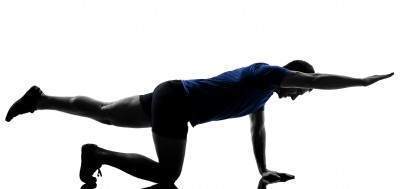
- Get into a crawling position with your hands and feet shoulder-width apart.
- Harden your core by contracting your abs and lower back. This is called bracing.
- Lift your arm first. If this is easy, then lift your leg only. If that is easy, then lift the opposite legs and arms, for example, right leg, and left arm.
- Want to make it tougher? Try lifting an arm and leg on the same side.
- 3 sets of 10. If you are shaking a little or cannot balance quite right, you’re doing the right exercise for you, i.e. lifting just the leg or arm might be easy, but lifting opposite arms and legs might put you off-balance a bit. Make sure you are stable before going to the advanced bird dog.
Tell us what you think in the comments below and like us on Facebook. This Toronto Downtown Chiropractor will answer all questions in the comments section. Let us know your vote for the best Toronto chiropractor in the comments section.
References
1. J Med Genet 2002;39:387-390 doi:10.1136/jmg.39.6.387
Related Categories: Disc Herniation, Elbow, Hip, Low Back Pain, Shoulder



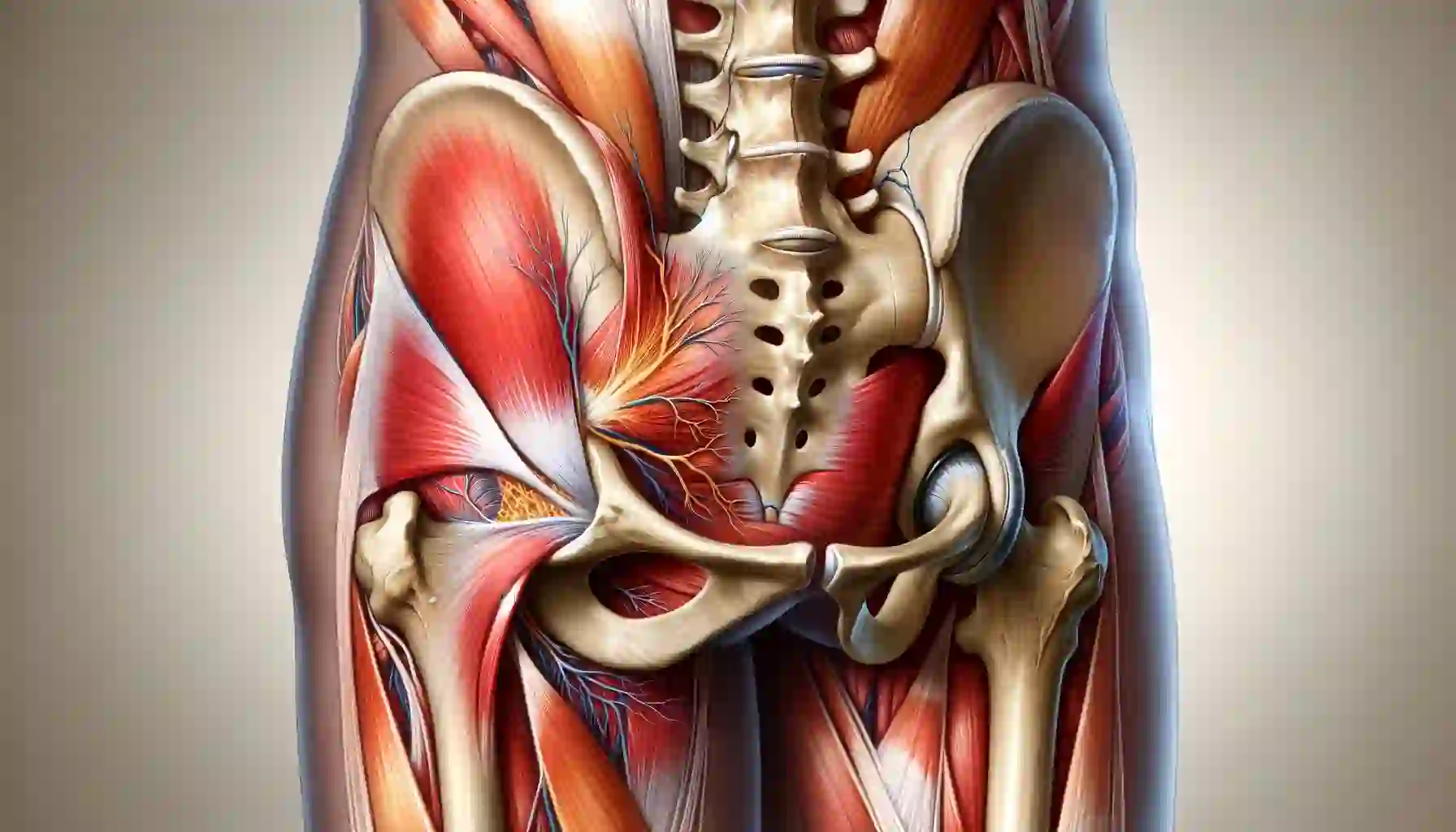
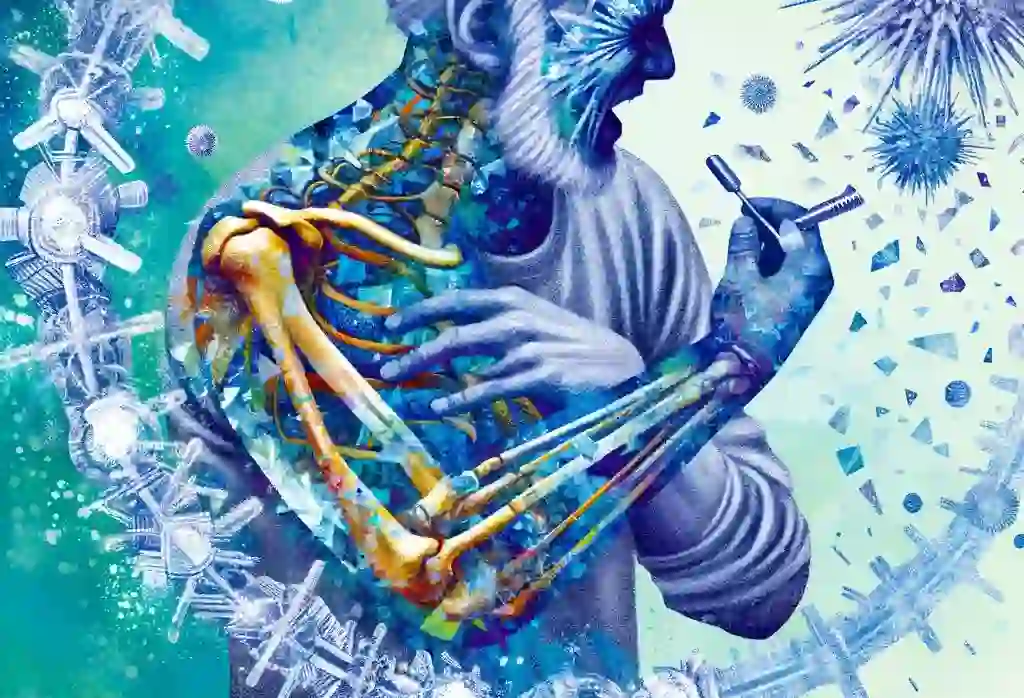
Dear Dr. How are you? Appreciated for your valuable feedback for the people who suffer with pain like me!
I am 35 yrs old and have a disc bulge and am suffering lot for the last one year, had taken the MRI and I am just write down the MRI results below, Expecting your feedback. What kind of exercise suits for my case? I am driving 30 KM per day by two wheeler and 5-6 hrs sitting job. Doctor advised to go for surgery but I am confused with multiple feedback and want to try with exercises first. Thanks in advance
MRI Results:
Annular tear with partial disc desiccation and diffuse disc bulge is seen at L3-4 level, narrowing bilateral neural foramina causing secondary compression of bilateral exiting nerve roots.
Disc desiccation with annular tear and postero-central disc prolapse is seen at L4-5 level narrowing spinal canal and bilateral neural foramina causing secondary compression of bilateral exiting and traversing nerve roots.
Diffuse disc bulge at L5-S1 narrowing bilateral neural foramina causing secondary compression of bilateral exiting nerve roots.
Mild facet arthrosis at L3-4 on left side.
Rest of the facet joints and neural foraminae appear normal.
The pedicles, laminae, spinous process and transverse process of the lumbar vertebrae show normal morphology. No evidence of spondylolysis.
The ligamentum flavum thickenss ios within normal limits. The bony spinal canal diameter measures.
Level L1 L2 L3 L4 L5
Cm 1.47 1.2 1.2 1.17 1.49
The spinal cord, conus medullaris and the sub arachnoid space are noraml. The nerve roots of the cauda equina appear normal. The paraspinal soft tissues appear normal.
Waiting for your reply. Thanks.
Regards,
Alexander.
Author
Thanks for coming by Alexander. Thanks for the greeting I am doing well. You have multiple levels of disc bulges with pressure on both sets of nerves. You are not likely to get far with a regular discectomy surgery. With multiple discs affected the problem is unless all the disc are operated on, they all have an affect on each other. The second issue is that the discs will likely bulge again unless the problem initially started from a trauma such as fall or car accident. The reason is if it happened from a lifting incident or simply bending over you likely have an inherent weakness that is genetically related.
The largest factor in disc herniation is genetics, followed by lifting, twisiting, vibration etc…
If you haven’t already done the exercises in this article you should try them. Here are some other exercises that you should try as well. https://www.bodiempowerment.com/sciatica-4-best-exercises/
While these exercises are fpr sciatica, they are helpful for bulges. Especially concentrate on the exercise for the piriformis, gluteus medius (picture of me with the medicine ball).
Hope that helps your disc bulge.
Thank you for your advice, I didn’t met an any accident or fallen from anywhere, i think the problem was started with an incident, I was trying climb in my new house building while construction is on without proper support. Even I am not sure this was the incident for this bulge. But I had severe pain by that time and might be aggravated after that incident. No body in my family had this kind of issue. I will do the exercises which mentioned by you. Can I drive a two wheeler by this condition? Can physiotherapy will solve the problem? Thanks and if you have any point let me know.
Alexander.
Author
Thanks for your question Alexander. Whether you ride a bicycle or motorbike the principle is the same. You need to stay upright and keep the arch in your lower back. If you lose the arch than you will get pain. Also you can do standing extensions before getting on and off the bike. The last thing is don’t ride for more than an hour at a time while you are in pain.
Hope that helps your lower back.
Dear Dr Ken,
Two years ago I developed sciatic pain in the sides of my quads. An MRI revealed a disk bulge L4/5 and an annular tear. Cycling brings on the pain and a flair up every few months when I am overdoing it. A trip to physio leads to me being given McKenzie stretches which ‘cure’ the intense pain but I always have lesser sciatic pain in legs and calves between major flare ups. Could I have other nerve damage that I should ask to be checked by a neurologist. Also in the last 2 months I have developed bad burning pain in both ankles and in the left leg this spreads right up to the knee. Ibuprofen/Ice calms it but won’t clear it. Any advice on any of this would be massively appreciated as it’s getting me down as I want to get back to cycling every week. Kind regards.
Author
Thanks for stopping by Chris. Sounds like you really love cycling. There are couple things to keep in mind while you are cycling. When you are cycling and you are upright you want to keep the arch in your back. Most cyclists especially serious cyclists will bend forward as it’s aerodynamically more efficient. Practice sitting in a chair with the arch in your lower back intact. 2nd arrow pose is a no go when you are trying to get better. You will find your flair-ups are likely related to arrow pose, lifting improperly or sitting too much especially with a bad posture.
You can also do standing Mckenzie’s (standing extensions in this article) before and after your biking if you are a short distance biker. If you are a long distance biker than you will keep aggravating your lower back.
You can also try doing these exercises. https://www.bodiempowerment.com/sciatica-4-best-exercises/
Hope that helps your sciatica.
Thanks, Dr Ken. I’ll definitely give all that a go. Much appreciated.
Author
You are welcome Chris.
Thank you for your reply Dr. Ken
Today I’ve got an appointment with the orthopedic surgeon who advised me a spinal fusion surgery. He ruled out microdissectomy because in my case the likelihood of a re-herniation is large in his opinion (narrowed space in L5S1 with more dark color in the mri) Do you think that is normal to suggest such an agressive tecnique for the first surgery? I know that this method can have some complications especially in the adjacent discs. i’m very afraid to undergo this type of surgery, thank you
Author
JP: You are welcome! My opinion is that yes it is true that there is a chance of re-herniation of the disc. I have seen it many times people getting microdiscectomy surgery. However fusion is much bigger surgery and you will definitely get degenerative disc disease above the fusion which will likley lead to early stenosis within 10-13 years. I hope your surgeon told you that. From a personal point of view I would try injections first. Than I would do microdiscectomy next. Last resort is fusion. This is off course provided you already did conservative care from two or three competent chiropractors, physiotherapists…etc…
Here are some related articles for you.
https://www.bodiempowerment.com/beware-surgery-low-back-pain/
https://www.bodiempowerment.com/disc-herniation-surgeries-half-fail/
Hope that helps your disc herniation.
Hello Doctor Ken, I’m a 33 year old (male) who exercices regularly. I’m with sciatica pain in my left leg in the past three and half months.(14 weeks) The pain is very intense in the morning and relieves in the afternoon and night. It has been stable in the last month. I d’ont have back pain right now but started with it. Also d’ont have loss of strength neither tingling in the leg. At the beginning i tried 5 sessions of osteopathy with no success. Then i tried some of your exercises for disc herniations part 2 but I have some discomfort and pain especially doing the cobra. Also tried the nerve flossing tecnique but i have more pain in the next day.(only tried for 2 days). Do you think i can wait more time if i can deal with my pain or will have to consider surgery? I’m afraid to stay with permanent damage in the sciatic nerve. thank you very much
My MRI says: Visible bulky l5-s1 disc herniation (11mm) center median and lateral, where the root s1 compresses against the yellow ligament. the spinal canal is wide and there are no signs of conflict space with the roots of horse tail. The remaining spinal segment observed only referring mild signs of disc degeneration, without any effect on nerve structures. Cone marrow and remaining intra-dural content unchanged.
x-ray says: Decreased space in l5-s1, slight scoliosis of lumbar rachis with left convexity. no other visible changes in load positions.
Author
Thanks for your story JP. When you have such a large disc herniation the exercises will not help it at least at this time. After 6 months most large disc herniations do get reabsorbed by the body. In your case though if I were in your position I would consider various injections to relieve the pain and you should consider surgery as your herniation is so large.
If you have foot drop, bowel or bladder issues pain or numbness on inner thighs and buttock or your disc herniationa is larger than 8mm and especially if any of these things are worsening than surgery is an foremost in my mind.
I would consult a neurosurgeon or orthopedic surgeon immediately in your case, and get the injection if the lead time to these appointments is a long time.
Hope that helps your disc herniation.
I am a 19 year old woman and have a herniated disc in the l-4/l-5 and l-5/s-1 discs ( also with what has been described to me as also a slight congenital defect that puts some pressure on this area). This happened after I had played fairly competitive tennis for years, and then continued to play and do some weightlifting (something I now know was really stupid) for another two and a half years with no let up. I have continued to feel significant though less intense and less ever-present pain for the last year and a half, and have had a little bit of physical therapy that has focused on stabilizing muscles in my legs, while keeping a neutral spine and engaging the abdominals. I have received three epidural cortisone shots, which have given me the most relief, although due to other medical reasons I cannot regularly continue to receive them the rest of my life, and don’t take all the pain away. I have also been evaluated by a surgeon, who said that my age and type of pain made me a bad candidate for surgery at this time. One problem I seem to be having is that while I occasionally have very light sciatic pain, most of my pain is directly in the low back, although the type varies slightly depending on whether I have been sitting up, standing, lying down, walking, or twisting. Most advice seems to be centered on people mainly suffering from sciatica, or those who have recently injured themselves, not those of us long-suffering but attempting some rehabilitation with direct low back pain.
My first question is will my back ever heal, even though it was (if I’m describing this the correct way) re-herniated multiple times because of continued impact?
My second question is which cardio exercises won’t hurt my back long term, but actually keep me in shape? I find myself used to being very athletic and in shape because of my tennis days, and in the last year and a half essentially have either felt too much pain to exercise, or don’t know what will hurt, and the inactivity is killing me!
My third questions are which ab/core and leg exercises won’t hurt me?
Fourth, is there anything that would help the pain of prolonged sitting up? I try to keep good posture with a neutral back, but hours studying in the library or going to class take their toll. The few exercises I have been given seem mainly to focus on the pain I receive walking or standing.
Thank you so much. Sorry if my explanation is not very good.
Author
Thanks for your questions Sara. The disc herniation diagnosis may be correct but the congenital defect puts a question mark on the advice I can give you. There are few types of congential defects in the lower back.
1. Fusion of the last vertebra to the vertebrae above
2. Extra Vertebrae at the bottom
3. Joints at the bottom of the spine are facing the wrong way.
1. I think that likely you have this congenital defect as you probably would have described them. This does put more pressure on the disc and causes abornormal wear and tear of the spine. If that is the case you will likely have pain but if you do the exercises it should help.
2. Cardio like swimming and biking are excellent for you. Even the eliptical if your symptoms aren’t too bad.
3. The exercises here will likely not hurt you but depends on the congenital defect.
4. Try rolling up a towel and taping both ends. Put that in the arch of your back and maintain your arch while you are sitting.
Hope that helps your disc herniation.
Dear Dr. Ken,
My lumbar MRI showed L3, L4 1mm disk bulges and a small annular tear on L4. My symptoms are mild low back dull tightness on the right that started about 2 months ago for no apparent reason, comes and goes daily. In the last year I’ve had two episodes of sharp pain radiating on the side of my left leg lasting for few days before subsiding. Both of these sciatica instances were triggered by a 4 mile run uphill with a backpack on. I have not repeated this run since. I’ve had minor sciatica symptoms for the last two years, like a slight left tight burn, a brief mild sharp poke in the buttock, etc. I did the 90 degree leg raise test and have no pain in the leg. Not sure if I have sciatica or piriformis. The hot water from a Jacuzzi makes the tight back go away while in the water. I have not taken any medication for this. What is your best guess is happening with my low back and leg and what is your prognosis? I am 45 years old male. Thank you
Author
Thanks for stopping by Mario. Most people have some wear and tear in the spines that are visible on MRI or X-ray by the time they are forty years old. The disc bulge is small but can still cause substantial pain including sciatica.
There are two things to keep in mind.
1. How you lift and go about your everyday activities is very important with the disc hernaitions. This is a link to what you should be careful of. https://www.bodiempowerment.com/disc-herniation-part-1/
2. Doing the exercises here on a consistent basis is also important.
Running: Running uphill puts you in a flexion position meaning it’s like you are bending forward at the hips to pick-up something (part way). Putting a backpack while doing this makes it worse. On the other hand running on flat ground with a backpack is fine as long as you don’t have acute pain.
Your disc bulges more when you went into flexion. As long you avoid that position and do these exercises on a regular basis you should be fine. Your prognosis is good based on the information that I have.
Hope that helps your disc herniation.
Author
Thanks for the questions Mario. When you run uphill this puts you in a position of flexion. This means that you are slightly bending forward. By putting on a backpack while doing this increases the pressure on your disc, causing it to protrude more and thus give you a disc bulge. Walking with a backpack on a flat ground is actually recommended for people with mild disc herniations like yourself, but not running with a backpack.
Yes you are right you can either disc herniation or piriformis syndrome but you more likely have a disc herniation / bulge as you got aggravated by running uphill.
I would try to avoid the things that aggravate a disc found in this article. https://www.bodiempowerment.com/disc-herniation-part-1/
Also try to do the exercises found in this article.
Hope that helps your disc herniation.
Thank you doctor. For the past 3 weeks I’ve only been swimming, walking and doing your exercises, including periformis stretches. I avoid flexion in daily activities. I am concerned running (on flat surface), basketball, soccer, weights, and machines would make my condition worse as they are high impact. I read somewhere that an MRI study showed extension exercises like you suggest reduce bulges.
My GP based on MRI only sent me to a spine and pain doctor for an epidural injection. The GP said it would prevent the bulge from getting worse. But I read spine injection does not help heal or prevent, it only might reduce pain. But my pain is not even for oral medication so injection does not make sense to me. The spine doctor was ready to give me the injection, as you said in the US this is a business. He ended up giving me a regular steroid shot 9 days ago in the buttock which didn’t help.
I went to another GP who also did a physical exam trying to induce back and leg pain but there was no sharp pain anywhere. I also went to a chiropractor. Like you they both said there is nothing serious here. They thought my chronic dull low back tightness is muscular not spinal. The GP also said the chronic leg pain is not spinal because it is not severe, comes and goes, and shows up at different places like front, back, knee, buttock, hip. At the gym I tried various leg stretches and tests myself but am not able to determine if it is sciatica or pirimormis. Since I see you are very experienced I am leaning toward this being mild sciatica and not piriformis. Thank you again Dr. Ken.
Author
You are welcome Mario. I am happy that you may have your answer. I hope your disc herniation (most likely) gets better soon.
Hi Dr. Ken,
It’s been 8 months since we last corresponded. Thank you for all the advice you gave me. It is interesting that once I stopped all physical activity (except walking) that my mild symptomps completely went away. It seems that even the cobra position, the extension table (did this with a Chiropractor), inversion board, piriformis and hamstring stretches were causing me pain simptomps. In the mean time I saw an orthopedist who refered me to a neurologist to do an EMG. The neuro examined me and said you don’t need an EMG. At the spot on the paperwork where it says diagnosis he left it blank. I recently went to a massage therapist and at the end of the massage he did a hamstring stratch. He said he hasn’t seen tighter hamstrings, especially the afected left leg where he couldn’t push my leg above 40 degrees (should be 90). So I started hamstring and piriformis stretches again as he was convinced that was where the problem was (not the 1mm disc buldge and annular tear which apparently everybody after 30 has). They don’t cause any pain while I am doing them only afterwards like the next day, minor pain in the hip area, front of upper leg and buttock. To minimize back exposure I do the hamstring stratch standing up doing basically a front split. The piriformis stretch is what the PT showed me 90/90 stratch standing up and one leg on the table. I also do the foam rolling he showed me to relax the muscles. I avoid all forms of flexion. So would you have any idea why if I don’t do anything I have no pain and when I do the excercises targeting sciatica I get sciatica? Shouldn’t it be the other way around? 🙂 I haven’t tempted an incline run, only flat surface and 5km of that give me a mild pain, so I gave that up as well. Thank you Doctor
Author
Thanks for your question Mario. It’s 30% of normal 30 years with no low back pain have disc herniations. That’s what the research says. Also 60% of 60 year old that have no low back pain have disc herniations. I emphasize this point that treating the MRI may get you anywhere. I did not mention this when I answered your comment but I often do. This is the article that states this. https://www.bodiempowerment.com/mri-ct-scan-x-rays/
Having said that, there are also different types of herniations. For an anterior disc bulge stretching the hamstrings which is almost always flexion of the spine is helpful.
Hope that helps.
Hi…..I have been diagnosed with cervical spondylosis…..I feel lot of tension headaches…stiff neck….and muscle spasm in shoulder blade….!! Suggest best excercises to put a check on this….
Author
Thanks for your comment Vishal. Try doing these exercises Vishal. https://www.bodiempowerment.com/neck-pain-exercises-deep-cervical-flexors/
Thank you Ken for giving ur prompt response…Its very overwhelming…!!! Well my GP says that forward bending of neck is not recommended in Cervical spondylosis……The exercises which u have designed to sort out my issues employe forward bending…..!!! I am in a fix…What should I be doing now????Please help…
Author
Why don’t you try doing your doctor’s exercises first. Sounds like your GP gave you list of exercises. I didn’t examine you or take your history so try the exercises that your GP gave you first and see how you do.
Hope that helps your cervical spondylosis.
Hi Ken…I am so glad to tell you that exercises recommended by you have done wonders to me…My scapular pain is almost gone….!!! Well my c5 is herniated and I do have diffused pain in my neck with tenderness…I wud be grateful if u suggest some very effective way to tackle my pain out of c5….Keep the faith
Author
Vishal just keep doing the exercises.
Good afternoon Dr.
I am a 50 year old male. I played football in highschool and some in college until my right knee would not allow me to continue (it still gives me issues with heavier squats and leg press after surgery in 2003). after that i engaged in bodybuilding for several years until I became a busy father.
Since then i have continued to exercise and work out. I no longer lift very heavy weight and keep my reps per set 8 or higher with sufficient warm up.
I recently was diagnosed (through MRI, CAT scan and neuological exam) with a herniated C-7 disk. I have received 2 nerve block / cortisone shots in the affected area and i am finally receiving some pain relief. I am able now to wean myself off the pain meds perscribed and strength is coming back to my left arm.
During the last 8 weeks since the onset, my left arm tricep has atrophied significantly.
My concerns are 4 fold:
1. I desire to avoid surgery in the future and wish to know how to best heal naturally. (nutrition, supplements, stretches, exercises etc…) What do you recommend?
2. I strongly wish to heal in a manner that will avoid reoccurance in the future. What is the best course of action?
3. I wish to maintian an active lifestyle and desire to reclaim my normally muscular body shape. Are there exercises I should avoid? Variations possibly? What exercises should i concentrate on?
4. What type of time frame should i expect for full recovery? How will i know if I am pushing recovery too fast?
Thank you for your valuable time.
Sinerely,
Toban Thompson
Author
Thanks for your comments Toban.
1. First try doing massage along the path of the pain. Try chin tucks here http://www2.nau.edu/~mtl8/Ther_Ex_files/Postural_ex.htm
Later try the chin tucks with extension bending backwards till the point of pain and continue in the pain-free range. 8X every 2 hours.
If you get sharp pain or increasing pain as you do this than you should stop
2. You can avoid by keeping the weights lighter as you said and restoring the curve in your neck and keeping the rest of posture in the proper position.
3. You should avoid head stands and heavy weights but you can virtually do all weighted exercises. Military press may aggravate you even with light weights but that will change as you get better. I gave you the exercises you should concentrate on in #1
4. Everybody is an individual so it is different for everybody given the same injury. Having said that the pressure on your nerve is quite severe considering the atrophy. You likely have an extrusion or sequestration of the disc which is the most severe type of disc herniation.
There are two scenarios. The extrusion or sequestration gets reabsorbed by the body in about 6 months time.(give or take a few months). With the reabsorbtion you start to feel better.
The body does not reabsorb the herniation enough in which case you will start compensating. Likely you will be left with pain that comes when you lift anything heavy in this case.
If you feel cold and hot sensations than you are getting worse. If you starting to get leg pain or pain down both legs than the disc is pushing substantially on your spinal cord. You would than need to see a neurosurgeon or orthopedic surgeon.
Either you need a neurosurgical or orthopedic consultation due to the pressure on your nerve.
Hope that helps your disc herniation in your neck.
So according to you my case is not that major?
I have pain but,I can walk for hours without pain,stand for hours.But the only problem comes when sitting.
My leg raise test results are negative.Left leg where there is pain rises only to about 45 degree and right leg to about 90 degree(This is when I am lying and raise my leg).Though there is a lot of improvement since the problem started.
While sitting when I try to raise my leg it pains a lot in left side of hip and the leg does not rises(both legs)
Author
Mrinank. I think that you have disc herniations with likely pressure on the nerve root which is quite serious. I would recommend doing these exercises and the sciatica article exercises.
Hope that helps your disc herinations.
Its been 5 months since the pain has started.So according to you my case is not that major?
I have pain but,I can walk for hours without pain,stand for hours.But the only problem comes when sitting.
My leg raise test results are negative.Left leg where there is pain rises only to about 45 degree and right leg to about 90 degree(This is when I am lying and raise my leg).Though there is a lot of improvement since the problem started.
While sitting when I try to raise my leg it pains a lot in left side of hip and the leg does not rises(both legs)
Dear Dr. Ken,
I had disc protrusion L4-5, in 2010, I was advised to take traction. All my pain was relieved. However this May 2014 suddenly pain started in left leg. Pain used to be severe when I use to get up from chair or sitting position. MRI report said:-
L5-S1: Prominent broadbased posterocentral left paracentral protrusion encroaches into the foramen and migrates inferiorly till the mid mid S1 Body, displaces the left transversing S1 nerve root posteriorly which is diffusely edematous. Relatively reduced lumbar bony canal diameter at L3 and L4 due to short pedicles.
Doctor asked me to undergo surgery. I refused and showed MRI to other doctor. He said it is minor and will recover with traction. However when I got admitted for traction, he also said go for surgery. I still refused and took traction for four days. then I should to well known surgeon in my town. He recommended for exercise and said pain will go in weeks time. I did exercise for just two days and there is no pain in leg. Only there is some pain in lower back (hip region). Mine is sitting job and need to sit for 8-9 hrs. The exercises given were quite similar that you have recommended
Please let me know what should I do. If this happens again and again. (this is second time after 4 years).
Many Thanks in advance.
Vinit
Author
Thanks for your comment Vinit.
There is something fundamentally wrong when a doctor doesn’t try conservative therapy first unless you fit these criteria.
1. You have progressively worsening symptoms or drop foot (you cannot lift your foot)
2. You have pain in the buttocks and the inside of your thighs (where a saddle would touch if you were sitting on a horse) with bowel and bladder function not longer working ie can’t pee or poo or having trouble with either.
3. Your disc is sticking out more than 8mm for discectomy surgery.
You should continue doing the exercises that got you better for now.
Hope that helps your disc protrusion.
Dear Dr. Ken,
Thank you very much for your reply. The MRI report also says that the protrusion (L5-S1) measures 0.8 x 2.2 x 1.4 cm (AP x transverse x craniocaudal). It indents the thecal sac and displaces the left transversing S1 nerve root posteriorly, the nerve root is bulky and mildly hyper intense on T2 suggesting edema. The canal measures 1.1 cm . Moderate left lateral recess stenosis.
Does this mean I need surgery? or can this be cured with exercise and when should we consider it as cured. Will pain in thigh and back go completely or will it remain life long.
Many thanks in advance,
Vinit
Author
Vinit: While a lot of factors including the massive size of your disc and the fact you have pedicles that are too short which can pressure on your nerves (cauda equina -thecal sac). If you don’t have the criteria for surgery that I outlined in my previous reply, and you are getting better with exercises you should keep going with the exercises.
Why don’t you consult a local chiropractor. I am not there to exam you. I am only going by what you are telling me and your MRI results.
Hope that helps.
thank for your exercise doctor…! i can hold to the right but feel very little pain buttock….! do i have to go for operation to recover??? any other exercise should i do for the left side and right side???
regards,
Kira
Author
Try the exercises on this page Kira and in this link also. https://www.bodiempowerment.com/sciatica-4-best-exercises/
Hi dr.Ken
My name is mrinank. I am 20yrs old.I am suffering from disc bulge for the past 5 months.The pain shoots to left side of Buttocks,back side of left thigs and sometimes on back side of calves.
My MRI reports says as follow:-
Mild loss of lumbar lordosis with straightening of the lumbar spine ? possibly due to muscle spasm.
IVD L1-2 appears normal.
IVD L2-3 appears normal.
IVD L3-4 appears normal.
IVD L4-5 appears normal.
IVD L5-S1 shows dessication, left paracentral disc bulge lateral canal disc extrusion in the para central and lat causing compression of the left neural foramen.
Mild thcal sac compresison is seen due to disc bulge.
Impression: MR imaging of lumbo-sacral spine reveals:-
1. Loss of the lumbar lordosis with straightening of the lumbar spine possibly due to muscle spasm.
. IVD L5-S shows dessication, left paracentral disc bulge, causing compression of the left lateral neural foramen.
Sir what should I do ?
Author
Thanks for your question Mrinank. I’m sorry that you are having pain when you are just 20 years old. THe L5S1 dessication means that you have wear and tear or degenerative disc disease (thinning of the disc). This is usually genetic for the most part although trauma to your spine can speed things up.
The good news is when you have an extrusion in about 6 months (give or take a few months) from when it first happens the disc is reabsorbed by the body via white blood cells etc…
For Exercises:You can try lying on your front to see if you can tolerate that. Work your way up to a sphinx than cobra. Try doing the exercises on this page and on this link.https://www.bodiempowerment.com/sciatica-4-best-exercises/
Hope that helps your disc herniation.
Hello Doctor.
I am having uncomfortable with my back pain, so i decided to go for MRI and here is my result…
L4 L5 Right Foraminal Disc Herniation
L5 S1 Severe Left Lateral Recess disc Herniation…
Left side i dun feel any pain since i go for chinese doctor last 2 years ago but on the right side i felt uncomfortable.. feeling like a sense on the right side… What should i do???
Author
Thanks for stopping by Kira. Your L4 L5 Right Foraminal Disc Herniation means that you have a disc herniation that is likely touching the dorsal root ganglion ie. the nerve. For most people this is quite painful. The L5S1 Severe Left lateral recess disc herniation means that your disc is blocking the hole where the disc exits.
Most people have problems with the formainal disc as is puts pressure on the nerve although both foraminal discs and lateral recess disc herniations both can put pressure on the nerve you are more likely to have nerve pinching with the foraminal disc herniation.
Try the exercises here first. If they don’t help you might benefit from bending sideways to the right with your and holding for a few seconds and trying that 8 times every two hours. If your disc is sticking out a lot this exercise will aggravate you. If your disc is sticking out moderately you will likely get relief. First do the other exercises in this article. if They don’t help or aggravate your problem try the exercise that I just explained.
http://www.stretchify.com/wp-content/uploads/2013/11/Side-Bend-Stretch-for-Hernia.png
The picture says it is for a hernia but I am just giving you a picture of the stretch that will help you.
Hope that helps
related to last post——-
My age is 22
Hello Doctor!!
i sufferd slip disc 4 months back while playing football.
My recent MRI report says—-
1. partially dessicated L5-S1 disc
2. Mild posterior disc bulge at L5-S1 level
though i have very little or no pain now.
Will be able to lift weights in Gym now or in future???
Author
Thanks for the question Rohit. With a mild disc bulge assuming the diagnosis is correct (You can have a disc bulge on MRI and have no pain) and that your doctor or health care professional did a thorough examination, most people recover quite nicely with the exercises given above. Try them out first.
You should be able to go back to the gym in a few months-6 months depending on the extent of your injuries.
The bad news is that you already have degenerative disc disease but it should not stop you from doing much. You will need to watch how you lift and watch your sitting and standing posture though to prevent problems.
This is important reading though.
https://www.bodiempowerment.com/disc-herniation-part-1/
Hope that helps your disc.
I have recently had an MRI on my C spine and I found out I have a bulging disc on C2-C4 and C5-C7. I am very concern as to the type of exercises to perform as the pain is terrible on my right side of the neck and most times at the back of my neck when stressed.
I enjoy doing yoga however I have stopped for quite some time. Can you advice on whether I can continue as well as with other form of exercises I can still perform to help maintain weight.
Thanks DR
Author
Thanks for your question Amina. With neck disc bulge you will have to see which exercises are suitable for you. Extension exercises where you bend your head back until you feel a little bit of pain. Stay within the painfree range. Do it 8 times every two hours.
If you get sharp pain with the exercises you should stop. If you get increasing pain while doing the exercises you should stop. If you get pain for more than 1/2 after the exercises you should not do that exercises.
Try that first.
Hope that helps your cervical disc herniation.
I’m 34 year old… male… 171 height. 65kg weight
MRI said i have bulging disc L4-L5 and L5-S1…
And i dont have pain anymore… only mild discomfort on my back… but, my body feel weak and especially my hip and below. And my right leg is more weak then the left… especially knee and below.. i cant sit for long time… if i did force myself to sit for a long time… i feel numbness on my leg .. sometimes it’s only right and sometimes is both…. so what i have to do? What kinds safe and best exercise for me? What’s the best position to driving a car? or passenger? Sedan car. And other things that i need to know?
Thank you
Author
Thanks for your questions Imam. Remember that just because the MRI says that you have a bulging disc does not necessarily mean that is the correct diagnosis. Millions of people of bulging discs and don’t have pain. Diagnosis by MRI is the one of the worst offences that western health practitioners make. If you want to read about this here it is: https://www.bodiempowerment.com/mri-ct-scan-x-rays/
Provided the diagnosis is correct the exercises here should help. Here are few more exercises.
https://www.bodiempowerment.com/sciatica-4-best-exercises/
While in a car make sure you keep the curve in your back by getting a lumbar roll (lumbar support roll) or if you roll up a towel and tape both ends and put that the most curved part of your lower back. It doesn’t matter if it’s a plane, car, SUV or sports car. Keeping the curve in your lower back is the most important.
Hope that helps your bulging disc.
Hi Dr. Ken.
Thank you for your time and energy. I have a question. I have a herniated disc L3 L4 and multi level Degenerative Disc Disease from there on down. The S1 disc is severely degenerated. My question is this. Fortunately, I am not experiencing a lot of pain. I am, however, dealing with a lot of numbness and weakness in my right leg. Occasionally there will be pain along the inside of my thigh. I thought I had strained or torn my inguinal tendon, but the neurosurgeon I consulted said those symptoms were from the bulging disc pressing on the nerve.
Are the exercises you’ve listed appropriate for me? I can not bring my pelvis back to a neutral spine, not because of pain, but because I have no flexibility. I feel like my back is constantly arched. Bending forward gives some relief, child’s pose, forward fold etc. What should I do as my doctor says I am not a candidate for surgery. This has been constant since March of this year.
Thanks again so much for your consideration.
Author
Thanks for your comment Adriana.
The pain on the inside of your thigh is likely coming from the disc herniation based on the anatomy. However looking at the nerve distribution the right leg weakness and numbness can be due to the severely degenerated dis at L5S1.
The disc herniation will put pressure on the thecal sac (extension of the spinal cord) By putting pressure on the thecal sac it triggered the nerve that comes out between the last vertebrae (L5S1).
You can try to do some like traction by laying across a table and letting your legs hang down letting the weight of your legs traction your lower back. Also you might try standing and hanging there for 30 seconds at a time at the beginning.
You likely have stenosis at L5S1
Hope that helps your stensois and disc herniation. If you have any more questions let me know.
Let me thank you in advance for giving proper guidence
I want to discuss my case as some 3 months ago i had a back pain and
after taking some medicines i was ok but after some time i felt that i have
a pain in my left leg.I went to physio therapist clinic and he referred me to some excerscises said you have a muscle problem in your left leg and you have to do
some exercises for stretching the musce. I did those exercises for one
months but there was no betterment. Meanwhile i also noticed that i feel
pain in my lowerback as well and this pain went down to my ankle and my left ass. This time i went to another hospital he said i think its heriniated disc He has
arranged an MRI and suggest for spine surgery to clear nerve root.
talking about MRI report. I had a disc herniation in L4-L5 of lumber spine cause nerve root of my left leg little bit block.so that i have huge pain in left leg and ass cause i cannot walk.
It has been almost 3 months since it started.Please suggest me exercises and also advise correct posture to sit and while driving.
I am waiting for your reply
Once’s again thank you sir
Author
Thanks for your comment Rajendra. You should get surgery when these indications are positive.
1. You have foot drop that is not getting better. You likely don’t have this
2. You have progressively worsening neurological symptoms.
3. Your disc herniation is 8 mm or larger.
You should try the exercises here in this article first than also try the sciatica exercises.
https://www.bodiempowerment.com/sciatica-4-best-exercises/
Try doing the exercises for 3 months. If any exercises gives you sharp pain stop right away. If you are in progressively more pain than you should stop the exercises. If you are in more pain for more than 1 hour stop.
Make sure you add only one exercise a day so you know what helps and what doesn’t.
If you are in India or US or UK I would be hesitant about recommendation for surgery due to the financial gains that the surgeons can get in those countries, It is also suspicious and actually very wrong to recommend surgery even before seeing the MRI to correlate with the clinical findings unless you have those criteria outlined above for surgery.
Hope that helps your disc herniation.